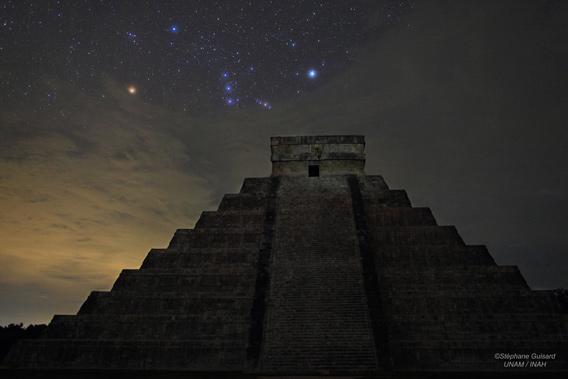On Mexico’s Yucatan Peninsula is the ancient Maya city of Chichen Itza. Its history reaches back over a thousand years, but it stands in ruins now, long abandoned.
That does nothing to reduce the magnificence of the Temple of Kukulkan, the iconic stepped pyramid standing 30 meters (100 feet) high at the north end of the main city. I visited there in the spring of 2011, and it was awe-inspiring. The architecture is incredible, and to think the Maya built it without even having used the wheel…
My family and I spent a long day there, enjoying ourselves and learning about this amazing civilization. We left in the early evening, but I now rather wish we had stayed a little later to see the stars come out. That’s because I received a note from my friend, astrophotographer Stéphane Guisard, with this photo he took of Orion rising over the mighty temple:

Image credit: Stéphane Guisard. Used by permission.
You really want to click that to see it in full resolution. The pale light gives the temple an eerie moodiness, and the colors of the stars in Orion are lovely. You can even make out the pinkish glow of the Orion Nebula, hanging below (to the right in the photo) the three bright stars in his belt. That nebula is a gas cloud many light years across and is a factory of star birth; the light from the massive stars born there light up the gas around them, making it so bright it’s easily visible to the naked eye from its staggering distance of over 1,300 light years—13 quadrillion kilometers, or 8 quadrillion miles.
Most of the stars you can see in Orion are young, massive stars, doomed one day to explode as supernovae. The famed Betelgeuse is probably the closest to that eventual fate, already having turned into a red supergiant due to exhausting its supply of fuseable hydrogen fuel in its core. You shouldn’t have any trouble spotting it in Stéphane’s photo; the color gives it away.
It’s funny to think that in a million years, maybe two, all those stars will be gone, exploded, destroyed. But that’s the lesson of Chichen Itza itself, isn’t it? This too shall pass.
And I can’t help but note that the city itself is located on the edge of the Chicxulub (pronounced CHICK-shoo-lube) crater, 180 kilometers (110 miles) across. It’s the impact site of the asteroid that wiped out the dinosaurs, along with a large fraction of all plants and animals on Earth at the time.
The layers of disaster lie thick at Chichen Itza. The land carved by an impact 65 million years ago, the city decaying for centuries, and the stars above it destined to go the way of the dinosaurs as well…
And one final thought. Even the crater from that impact itself has eroded over the eons to the point where it was difficult to find, despite its size. Even disasters suffer disasters, given enough time.